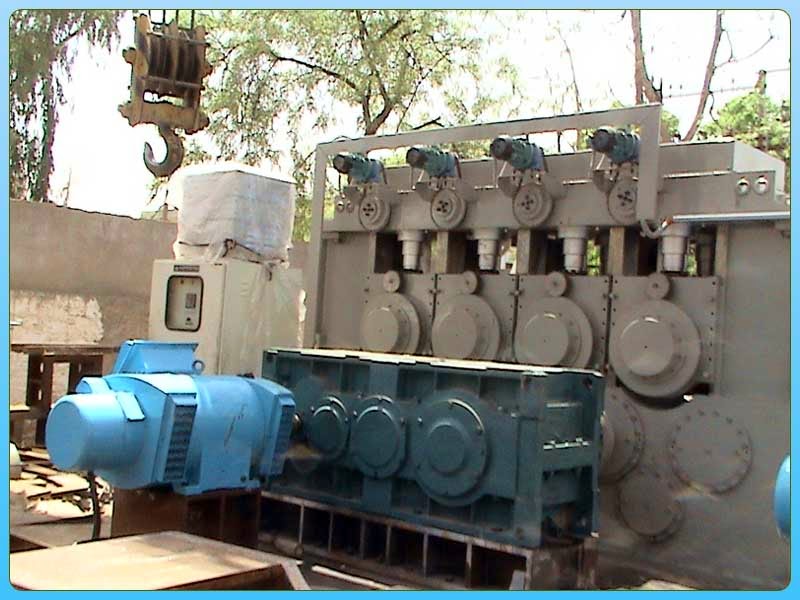The motivation behind straightening in an average curl food line is to set up the material to permit it to pass openly through the kick the bucket and produce worthy parts. Prerequisites shift relying upon any material abandons, the configuration of the kick the bucket and completed part necessities. Straightening is refined by bowing the strip around sets of rollers that then again extend and clamp the strip's upper and more level surfaces, surpassing material yield point so both surfaces wind up the same length after springback. The consequence: even material.
Sorts of Straightening Machines
Straightening machines fall into two essential classes straighteners (or flatteners) and restorative levelers. Straighteners normally work five to 11 work rolls whose measurement and fixate separations differ relying upon workpiece-material thickness and width. By and large, rollers are decently expansive in measurement, generally divided and not moved down. Straighteners will evacuate curl set from the material, permitting it to pass unlimited through the bite the dust and fulfilling generally requisitions.
Restorative levelers will evacuate loop set as well as camber, wavy edges, focus clasps and trapped anxieties inside the material, so it will stay even in the wake of transforming through a pass on. These machines are recognized by little width nearly dispersed moves with reinforcements and the capacity to flex the rolls. They ordinarily have a more stupendous number of work moves than routine straighteners, and since they work the material much harder and their moves might be flexed, exactness levelers dependably are controlled. Thusly, they require more compelling drives than do straighteners.
Power straighteners might be arranged as a major aspect of the unwinder, as on account of curl supports, or for draw off operation with loop reels. They likewise might be unattached with a second slack circle between the straightener and unwinder—as with bed decoilers or in situations where fragile material might be harmed by pulling off of
an extensive loop.
Straighteners, then again, might be fueled or nonpowered—called force through straighteners. As the name prescribes, here the food gives the ability to draw the strip through the straightener. The preferences of this style: minimal effort, and, since the straightening operation happens after the circle, circle length might be dense without the stress that loop set will be reinduced into the material.
With force through straighteners, torque must be drawn from the feeder. This can either lessen its speed competence or enormously expand cost. Extra disservices to draw through straighteners incorporate material checking, ought to the nonpowered straightening moves slip on the material throughout begins and stops; and mistake from food slippage, because of the extra load.
Power straighteners or levelers might be designed as a feature of the unwinder, as on account of loop supports, or for draw off operation with curl reels. They likewise could be unattached with a second slack circle between the straightener and unwinder—as with bed decoilers or in situations where sensitive material might be harmed by pulling off of a huge loop.
.
Straightening Machine | Angle Straightening | Transmission Line Tower | Rolling Mill Equipment | Design Fabrication
Sorts of Straightening Machines
Straightening machines fall into two essential classes straighteners (or flatteners) and restorative levelers. Straighteners normally work five to 11 work rolls whose measurement and fixate separations differ relying upon workpiece-material thickness and width. By and large, rollers are decently expansive in measurement, generally divided and not moved down. Straighteners will evacuate curl set from the material, permitting it to pass unlimited through the bite the dust and fulfilling generally requisitions.
Restorative levelers will evacuate loop set as well as camber, wavy edges, focus clasps and trapped anxieties inside the material, so it will stay even in the wake of transforming through a pass on. These machines are recognized by little width nearly dispersed moves with reinforcements and the capacity to flex the rolls. They ordinarily have a more stupendous number of work moves than routine straighteners, and since they work the material much harder and their moves might be flexed, exactness levelers dependably are controlled. Thusly, they require more compelling drives than do straighteners.
Power straighteners might be arranged as a major aspect of the unwinder, as on account of curl supports, or for draw off operation with loop reels. They likewise might be unattached with a second slack circle between the straightener and unwinder—as with bed decoilers or in situations where fragile material might be harmed by pulling off of
an extensive loop.
Straighteners, then again, might be fueled or nonpowered—called force through straighteners. As the name prescribes, here the food gives the ability to draw the strip through the straightener. The preferences of this style: minimal effort, and, since the straightening operation happens after the circle, circle length might be dense without the stress that loop set will be reinduced into the material.
With force through straighteners, torque must be drawn from the feeder. This can either lessen its speed competence or enormously expand cost. Extra disservices to draw through straighteners incorporate material checking, ought to the nonpowered straightening moves slip on the material throughout begins and stops; and mistake from food slippage, because of the extra load.
Power straighteners or levelers might be designed as a feature of the unwinder, as on account of loop supports, or for draw off operation with curl reels. They likewise could be unattached with a second slack circle between the straightener and unwinder—as with bed decoilers or in situations where sensitive material might be harmed by pulling off of a huge loop.
.
Straightening Machine | Angle Straightening | Transmission Line Tower | Rolling Mill Equipment | Design Fabrication


No comments:
Post a Comment